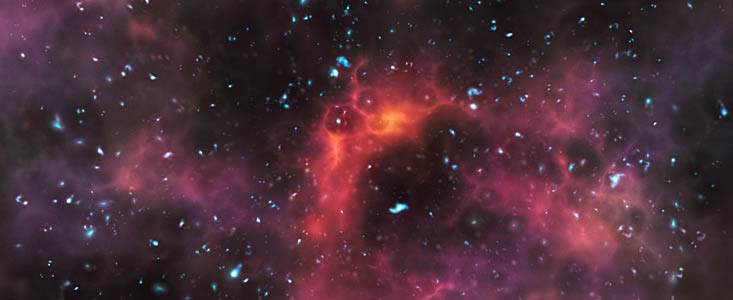An international team of astronomers used the VLT as a time machine, to look back into the early Universe and observe several of the most distant galaxies ever detected. They have been able to measure their distances accurately and find that we are seeing them as they were between 780 million and a billion years after the Big Bang [1].
The new observations have allowed astronomers to establish a timeline for what is known as the age of reionisation [2] for the first time. During this phase the fog of hydrogen gas in the early Universe was clearing, allowing ultraviolet light to pass unhindered for the first time.
The new results, which will appear in the Astrophysical Journal, build on a long and systematic search for distant galaxies that the team has carried out with the VLT over the last three years.
“Archaeologists can reconstruct a timeline of the past from the artifacts they find in different layers of soil. Astronomers can go one better: we can look directly into the remote past and observe the faint light from different galaxies at different stages in cosmic evolution,” explains Adriano Fontana, of INAF Rome Astronomical Observatory who led this project. “The differences between the galaxies tell us about the changing conditions in the Universe over this important period, and how quickly these changes were occurring.”
Different chemical elements glow brightly at characteristic colours. These spikes in brightness are known as emission lines. One of the strongest ultraviolet emission lines is the Lyman-alpha line, which comes from hydrogen gas [3]. It is bright and recognisable enough to be seen even in observations of very faint and faraway galaxies.
Spotting the Lyman-alpha line for five very distant galaxies [4] allowed the team to do two key things: first, by observing how far the line had been shifted toward the red end of the spectrum, they were able to determine the galaxies’ distances, and hence how soon after the Big Bang they could see them [5]. This let them place them in order, creating a timeline which shows how the galaxies’ light evolved over time. Secondly, they were able to see the extent to which the Lyman-alpha emission — which comes from glowing hydrogen within the galaxies — was reabsorbed by the neutral hydrogen fog in intergalactic space at different points in time.
“We see a dramatic difference in the amount of ultraviolet light that was blocked between the earliest and latest galaxies in our sample,” says lead author Laura Pentericci of INAF Rome Astronomical Observatory. “When the Universe was only 780 million years old this neutral hydrogen was quite abundant, filling from 10 to 50% of the Universe’ volume. But only 200 million years later the amount of neutral hydrogen had dropped to a very low level, similar to what we see today. It seems that reionisation must have happened quicker than astronomers previously thought.”
As well as probing the rate at which the primordial fog cleared, the team’s observations also hint at the likely source of the ultraviolet light which provided the energy necessary for reionisation to occur. There are several competing theories for where this light came from — two leading candidates are the Universe’s first generation of stars [6], and the intense radiation emitted by matter as it falls towards black holes.
“The detailed analysis of the faint light from two of the most distant galaxies we found suggests that the very first generation of stars may have contributed to the energy output observed,” says Eros Vanzella of the INAF Trieste Observatory, a member of the research team. “These would have been very young and massive stars, about five thousand times younger and one hundred times more massive than the Sun, and they may have been able to dissolve the primordial fog and make it transparent.”
The highly accurate measurements required to confirm or disprove this hypothesis, and show that the stars can produce the required energy, require observations from space, or from ESO’s planned European Extremely Large Telescope, which will be the world’s largest eye on the sky once completed early next decade.
Studying this early period in cosmic history is technically challenging because accurate observations of extremely distant and faint galaxies are needed, a task which can only be attempted with the most powerful telescopes. For this study, the team used the great light-gathering power of the 8.2-metre VLT to carry out spectroscopic observations, targetting galaxies first identified by the NASA/ESA Hubble Space Telescope and in deep images from the VLT.


this is a test and I want to see if ill have the same problem as DS